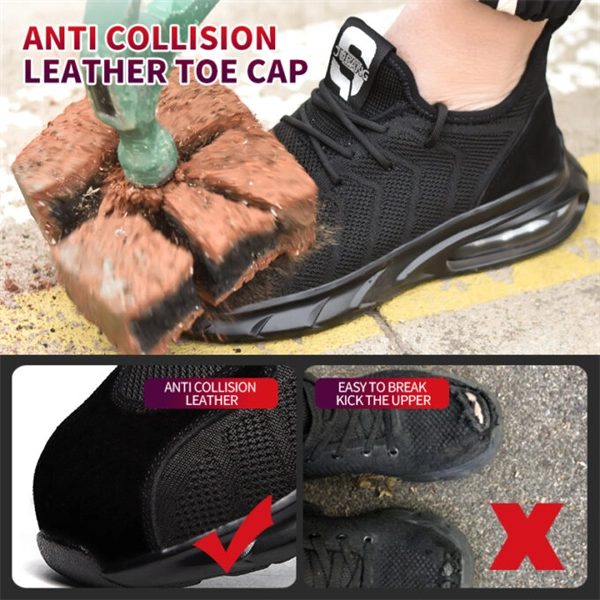How I Avoided a Hospital Trip Thanks to Kevlar Protection: A Construction Worker’s Tale

When they say “safety first” on construction sites, they’re not just throwing around empty phrases. I learned this lesson the hard way—or rather, the lucky way—when my safety boots saved me from what could have been a devastating injury and an expensive hospital visit.
The Day My Safety Shoes Earned Their Keep
It was just another Tuesday on the high-rise project downtown. I’d been working 10-hour shifts for nearly two weeks straight as we raced to meet our deadline. Maybe that’s why I wasn’t as alert as I should have been when I was clearing debris near the elevator shaft.
I still remember the sound—a metallic scrape followed by a heavy thud. A contractor had accidentally knocked a toolbox off the scaffolding above me. Inside was a set of heavy-duty drill bits and a rusty nail gun that came crashing down.
The toolbox missed me, but one of the drill bits landed directly on my right foot. The second drill bit somehow landed point-down, right on the same spot.
In that moment, time seemed to slow down. I braced for the pain, for the rush to the ER, for weeks of recovery and lost wages. But instead, I felt… nothing. Well, not nothing—I felt pressure, but no piercing pain.
Looking down, I realized my safety boots had done exactly what they were designed to do. The steel toe cap had absorbed the impact of the falling tools, and the Kevlar midsole had prevented the sharp drill bit from penetrating through to my foot.
Why Proper Safety Footwear Matters More Than You Think
That near-miss was a wake-up call. According to OSHA, foot injuries account for nearly 10% of all reported workplace accidents, with many resulting in lost workdays and permanent damage. What’s more shocking is that most of these injuries could be prevented with proper footwear.
In my case, I was wearing safety boots with:
- An ISO 20345-certified steel toe cap (capable of withstanding 15KN pressure and 200J impact)
- A Kevlar anti-puncture midsole (resistant to 1100N of penetration force)
- A slip-resistant PU outsole that kept me steady even on the debris-covered floor
These features aren’t just technical specifications—they’re the difference between a near-miss story and a life-altering injury.
Comfort Meets Safety: No More Excuses
I’ve heard all the excuses from my fellow construction workers:
“Safety boots are too heavy.” “They hurt my feet after a couple of hours.” “They’re too hot in summer.” “They look clunky and ridiculous.”
I used to say the same things until I found boots that combined safety with comfort. The pair that saved me that day featured:
- A breathable mesh upper that kept my feet cool even in the summer heat
- An insole with 3D arch support that made 10-hour shifts bearable
- Lightweight design that didn’t drag me down by the end of the day
- Modern styling that didn’t scream “industrial safety equipment”
The Financial Math of Safety Investment
Let’s break down the numbers. A quality pair of safety boots with Kevlar protection might cost around $150-200. Compare that to:
- The average ER visit: $1,389 (according to UnitedHealth Group)
- Lost wages from being unable to work: $800-1,500 per week (based on construction industry averages)
- Potential long-term disability: incalculable
That’s not even counting the pain, stress, and impact on family life.
As my foreman always says, “The cost of good safety equipment is always less than the cost of an accident.” After my experience, I couldn’t agree more.
Beyond the Workplace: Versatility in Safety Footwear
What surprised me most about my safety boots was how versatile they proved to be. The same boots that protected me at work became my go-to footwear for:
- Weekend home renovation projects
- Hiking on rocky terrain
- Working in the yard with power equipment
- Even motorcycle riding in inclement weather
The vibrant, modern design means they don’t look out of place in casual settings, unlike the clunky safety boots of the past. They’ve become a staple in my wardrobe, offering protection without sacrificing style.
The Peace of Mind Factor
Perhaps the most valuable aspect of proper safety footwear isn’t physical—it’s psychological. Since my near-miss, I’ve noticed I move more confidently on the job site. I’m less hesitant to step into potentially dangerous areas (while still being cautious, of course), and I worry less about what might happen if something goes wrong.
That peace of mind translates to better focus, better work quality, and ultimately, better safety overall.
What To Look For In Quality Safety Footwear
After my experience, I’ve become something of an unofficial safety footwear advocate on my crew. Here’s what I tell my colleagues to look for:
- Certification matters: Look for ISO 20345 certification for the toe cap
- Kevlar protection: This lightweight material offers superior puncture resistance
- Comfort features: Breathable materials and proper arch support are non-negotiable
- Grip and traction: The best protection is preventing slips and falls in the first place
- Durability: Military-grade materials ensure your investment lasts longer
Frequently Asked Questions About Safety Footwear
How often should I replace my safety boots?
Most safety professionals recommend replacing work boots every 6-12 months depending on usage. If you notice visible damage, worn tread patterns, or decreased comfort, it’s time for a new pair—regardless of age.
Can safety boots with Kevlar really stop a nail?
Yes! Kevlar midsoles rated at 1100N can prevent penetration from most construction hazards, including nails, screws, and metal shards. My personal experience confirms this.
Are lightweight safety boots less protective?
Not necessarily. Modern materials like Kevlar offer excellent protection while weighing significantly less than traditional materials. The key is looking for proper certification, not just weight.
Are expensive safety boots worth the investment?
Absolutely. When you consider the potential costs of injury, lost work time, and medical bills, quality safety footwear is one of the best investments you can make in your personal wellbeing.
The Lesson I Learned
That falling toolbox taught me something no safety seminar ever could: proper protection isn’t just a workplace requirement—it’s a necessity that could save your foot, your job, and your quality of life.
I now have a daily reminder of how quickly things can go wrong on a construction site, and how the right equipment can make all the difference. Every morning when I lace up my boots, I remember that I’m not just putting on footwear—I’m putting on protection that could prevent a life-changing injury.
If you work in construction, manufacturing, or any industry where foot hazards exist, don’t wait for your own near-miss story. Invest in quality safety footwear with Kevlar protection and steel toe caps. Your future self will thank you—possibly from somewhere other than a hospital bed.
🛠️ Ready to protect your feet like a pro? Check out our selection of safety boots with Kevlar protection and start working with confidence today! 👷♂️
